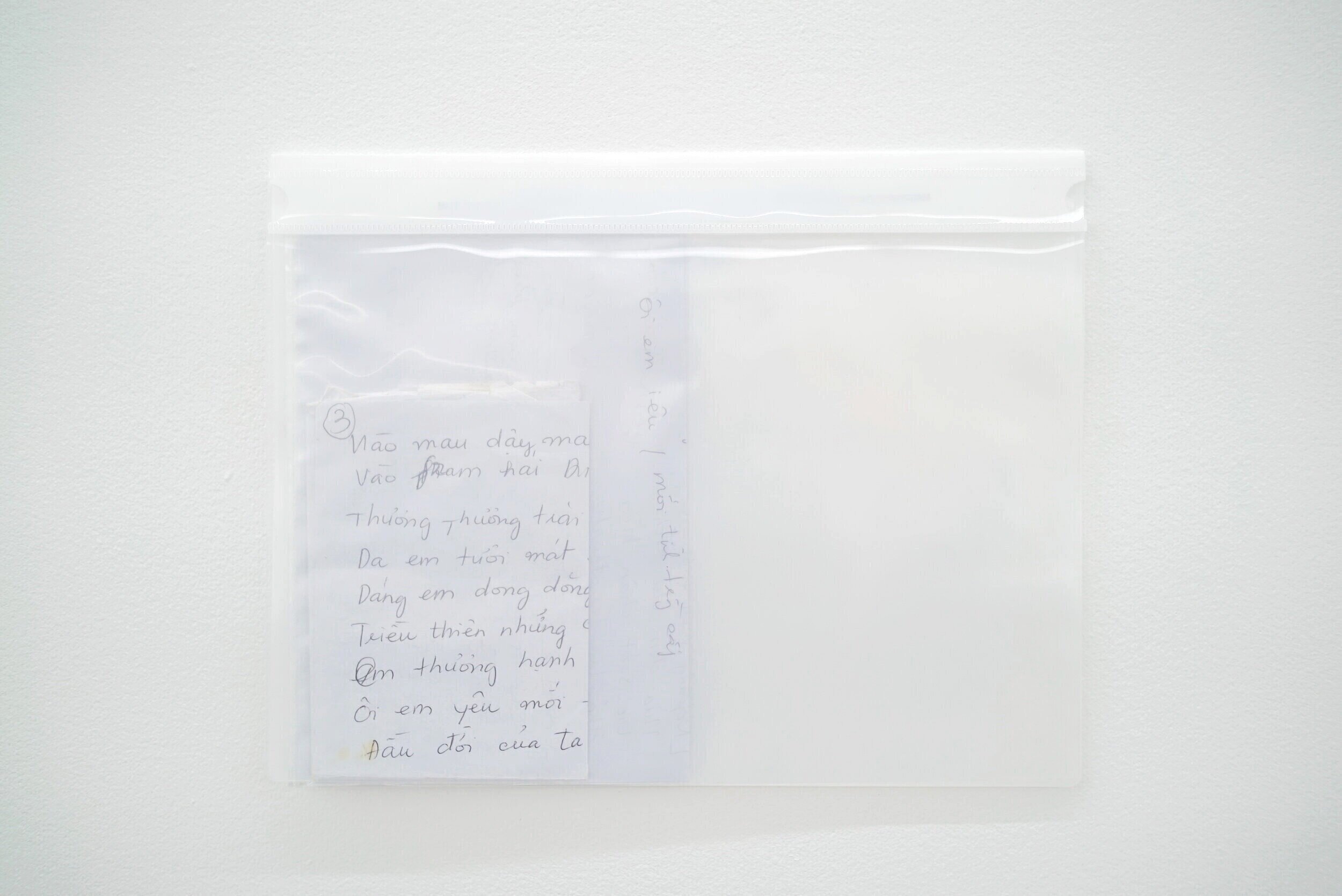
“collaborating, translating, and archiving with family in Australian contemporary art.”
* “Chó bò” is the approximate Vietnamese homonym for “trouble.”
Literally translated, “chó bò” is a “dog cow” or“dog crawl.” Either way, these linguistic slips produce an absurdist assemblage, a troubling word play when spoken. As we try to pronounce the word “trou ble,” we throw the dog among the cows, forcing it to crawl on its’ belly.
“Chó bò,” is a common joke for manyVietnamese people living in English-speaking countries. Often perceived by others as troubling and troublesome, we carry the linguistic and political means to make big epistemic trouble. Twisting our tongues to mimic the normative structures around us, our informal acts of translation, imperfect speech, and language brokering can metaphorically articulate the troubles surrounding us, including the most troubling parts of the Vietnamese diaspora itself.

( pictured is a draft translation of the Acknowledgement of Country to the Wurundjeri and Boon Wurrung in Vietnamese, Nguyễn Thị Kim Nhung and James Nguyen, 2018 )
Chúng tôi trân thành cảm ơn người Wurundjeri và người Boon Wurrung, và các tổ tiên của đất nước Kulin của người ấy. Trên mẳnh đất này bị người khách lấy đi, mà không phải nhừơng, chung tôi tại đây đã đến sống, làm việc, và hôm nay chúng tôi đến từ nơi khác, để chia sẻ những cầu chuyện này.
( hands hovering over a puddle of water with Vietnamese text of an Acknowledgement of Country to the Wurundjeri and Boon Wurrung overlaying the moving image )
On The Border Of Things (Part II), with producer Bron Belcher and presented at Next Wave Festival. Nguyễn Thị Kim Nhung, Nguyễn Công Aí, Hayley Forward (composer), and James Nguyen, 2018.
( the moving image file above includes the English captions, voiceovers, and soundtrack from the live performance. Approximately 16:15 minutes duration, the performance structures various forms of story-telling and nostalgia around the realities of reconnecting with estranged family members and landscapes. This includes the frustrating work of waiting on Telstra and the National Broadband Network to run a business and to find family.
A series of still images accompanies the moving image file:
Image 1 : hand-written draft of the lyrics, voice-overs, and dialogue for the performance, pictured here in a plastic sleeve.
Image 2 : Nguyễn Thị Kim Nhung stands on the back of a ute, speaking the Acknowledgement of Country to the Wurundjeri and Boon Wurrung in Vietnamese, as English language captions plays on the monitor behind her. Also dressed in white, the other performer James Nguyen stands on the ground to her right. Photograph by Snehargho Ghosh.
Image 3 : Squatting on the back of the ute to apply theatre makeup on each other, performer James Nguyen picks up a makeup pen to paint a beard on Nguyễn Thị Kim Nhung. Photograph by Snehargho Ghosh.
Image 4 : Both performers don cloud/zucchini shaped paper hats as they play air-guitar behind the ute. Photograph by Snehargho Ghosh.
Image 5 : Both performers look directly to camera as they kneel in a puddle of water with the ute in the background. Photograph by Anne Moffat.


A selection of birthday photographs used for the Australian Family Reunion Visa, ( pictured in a plastic sleeve these photographs are shown facing the wall ) the Nguyễn Family photo album, 1986-1989.

Portion 53, curated by Anna Davis and Clothilde Bullen for The National Exhibition 2019, Museum of Contemporary Art, Australia. Nguyễn Thị Kim Dung, Nguyễn Ngọc Cư, Kezia Yap (composer), and James Nguyen, 2019.
( three channel moving image installation, individually repeating and ranging from 9:21 to 13:33 minutes in duration, this work depicts the Nguyễn family returning to the site of the Easthills Migrant Hostel where Nguyễn Ngọc Cư was processed as a newly arrived Vietnamese refugee in Australia. The first channel has Nguyễn Ngọc Cư recalling his experience and the changes that have occurred since. The second channel records James Nguyen playing with pieces of found polystyrene as a percussive intervention. The third channel has Nguyễn Thị Kim Dung reciting her poem, reflecting on her resettlement as part of an ongoing process of settler-colonial violence.
A series of still images accompanies the three moving image channels above:
Image 1 : hand-written drafts of Nguyễn Thị Kim Dung’s poem, written in Vietnamese and on discarded pieces of dress pattern making paper and scrapbook notes, pictured in a plastic sleeve.
Image 2 : the three channel work is presented side by side on three flat screen monitors. These sit on a timber shelf, in front of a group of matching boxed seating for the audience. Photograph by Zan Wimberley.
Image 3 : a partial sideways perspective of how the work was installed before opening at the museum. A large-scale painting ‘Kamantaku Tjukurpa wiya’ by Kunmanara Williams is visible in the distance. Photograph by Zan Wimberley.
Image 4 : pictured is the three channel moving image work saved onto three separate UBS sticks, labelled and kept in a clear plastic sleeve. Photograph by James Nguyen )








